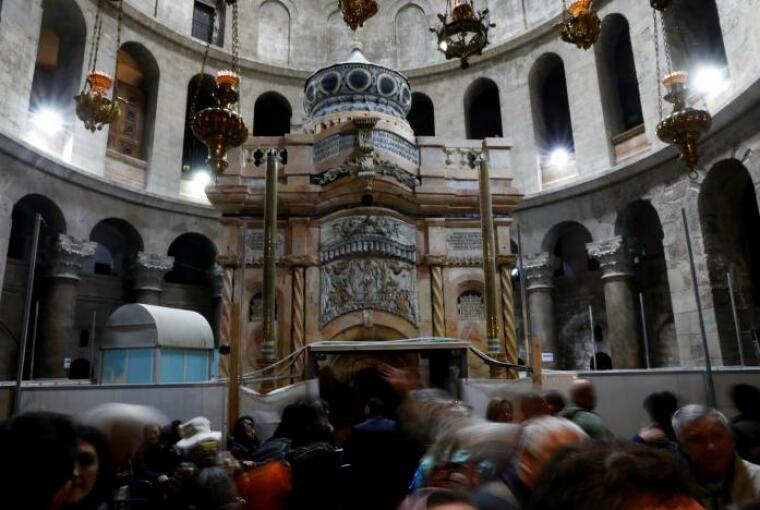National Geographic Museum launches 3D exhibit of burial site of Christ

The National Graphic Museum in Washington, D.C. has launched a new 3-D exhibit called "Tomb of Christ: The Church of the Holy Sepulchre Experience" to allow visitors to catch a glimpse of one of Christianity's holiest sites in Jerusalem.
The exhibit, which opened on Nov. 15, will allow people to virtually visit what some believe to be the ancient tomb where Jesus' body was laid after the Crucifixion.
The Church of the Holy Sepulchre recently underwent significant renovations, which has led to some notable finds, including what archaeologists say could be the original limestone bed where Jesus was laid on.
"I'm absolutely amazed. My knees are shaking a little bit because I wasn't expecting this," Fredrik Hiebert of National Geographic said at the time.
"We can't say 100 percent, but it appears to be visible proof that the location of the tomb has not shifted through time, something that scientists and historians have wondered for decades," he continued.
National Geographic noted that the visitors to its latest exhibit will learn all about the historic renovation, which also revealed part of the bedrock from the original cave where Jesus is said to have been buried before the Resurrection.
In October 2016, the original surface of the tomb was exposed for the first time after the scientists removed the marble cladding that covered it since at least 1555 A.D.
"The marble covering of the tomb has been pulled back, and we were surprised by the amount of fill material beneath it," Hiebert said after the tomb was uncovered.
"It will be a long scientific analysis, but we will finally be able to see the original rock surface on which, according to tradition, the body of Christ was laid," he added.
The virtual tour will allow guests to see the Edicule, which is the ornate shrine within the Church of the Holy Sepulchre that encompasses the remains of the rock-cut tomb.
The exhibit will also feature the cutting-edge technology that was used to document the restoration, according to The Christian Post.
The restoration work at the church started last year after Israeli authorities deemed the site unsafe. There had been fears in May 2016 that the holy site was "on the verge of collapse" due to its age.
Antonia Moropoulou, who directed the work at the site, said that the structure at the church needed reinforcement and conservation, including work on drainage network for rainwater and sewage.
The Greek Orthodox, Roman Catholic and Armenian Orthodox churches all pitched in to help fund the $3.4 million project. Some world leaders, including King Abdullah of Jordan, also donated money for the restoration of the site.
 Christians don't have to affirm transgenderism, but they can’t express that view at work: tribunal
Christians don't have to affirm transgenderism, but they can’t express that view at work: tribunal Archaeology discovery: Medieval Christian prayer beads found on Holy Island
Archaeology discovery: Medieval Christian prayer beads found on Holy Island Presbyterian Church in America votes to leave National Association of Evangelicals
Presbyterian Church in America votes to leave National Association of Evangelicals Over 50 killed in 'vile and satanic' attack at Nigerian church on Pentecost Sunday
Over 50 killed in 'vile and satanic' attack at Nigerian church on Pentecost Sunday Ukrainian Orthodox Church severs ties with Moscow over Patriarch Kirill's support for Putin's war
Ukrainian Orthodox Church severs ties with Moscow over Patriarch Kirill's support for Putin's war Islamic State kills 20 Nigerian Christians as revenge for US airstrike
Islamic State kills 20 Nigerian Christians as revenge for US airstrike Man who served 33 years in prison for murder leads inmates to Christ
Man who served 33 years in prison for murder leads inmates to Christ


 Nigerian student beaten to death, body burned over ‘blasphemous’ WhatsApp message
Nigerian student beaten to death, body burned over ‘blasphemous’ WhatsApp message 'A new low': World reacts after Hong Kong arrests 90-year-old Cardinal Joseph Zen
'A new low': World reacts after Hong Kong arrests 90-year-old Cardinal Joseph Zen Iran sentences Christian man to 10 years in prison for hosting house church worship gathering
Iran sentences Christian man to 10 years in prison for hosting house church worship gathering French Guyana: Pastor shot dead, church set on fire after meeting delegation of Evangelicals
French Guyana: Pastor shot dead, church set on fire after meeting delegation of Evangelicals ‘Talking Jesus’ report finds only 6% of UK adults identify as practicing Christians
‘Talking Jesus’ report finds only 6% of UK adults identify as practicing Christians Mission Eurasia ministry center blown up in Ukraine, hundreds of Bibles destroyed: 'God will provide'
Mission Eurasia ministry center blown up in Ukraine, hundreds of Bibles destroyed: 'God will provide' Church holds service for first time after ISIS desecrated it 8 years ago
Church holds service for first time after ISIS desecrated it 8 years ago Burger King apologizes for 'offensive campaign' using Jesus' words at the Last Supper
Burger King apologizes for 'offensive campaign' using Jesus' words at the Last Supper Uganda: Muslims abduct teacher, burn him inside mosque for praying in Christ’s name
Uganda: Muslims abduct teacher, burn him inside mosque for praying in Christ’s name